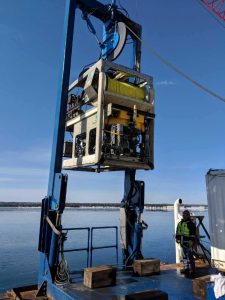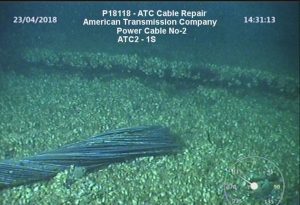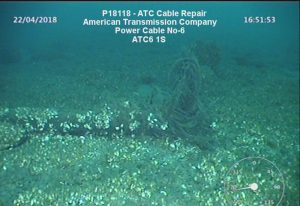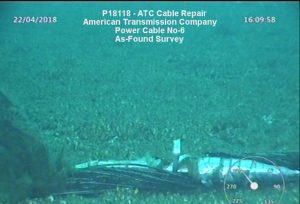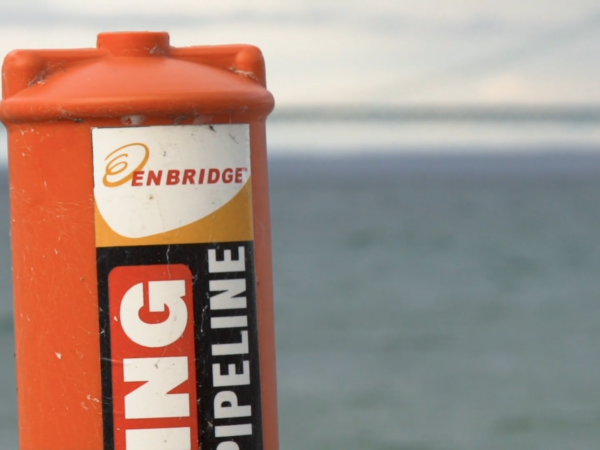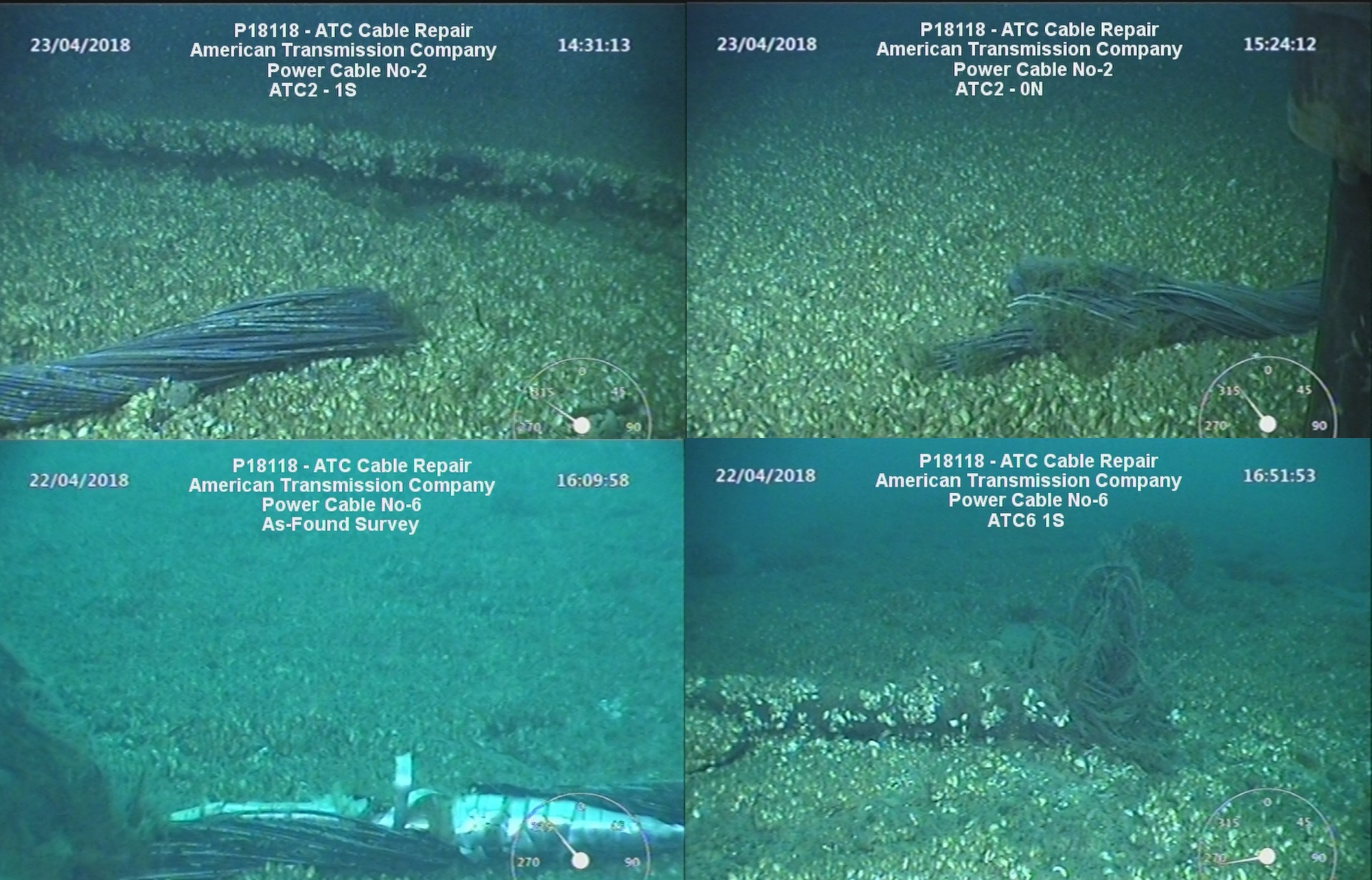
“This is probably everybody’s worst fear”
Detroit Public Television’s Great Lakes Bureau has been in contact with The U.S. Coast Guard’s Unified Command, the group of state and federal agencies responding to a 600-gallon spill in Michigan’s Straits of Mackinac, ever since a chemical leak caused by an anchor-dragging incident that damaged powerlines was revealed at the beginning of April.
Due to severe weather conditions with snow, ice and waves up to 12 feet high, no U.S. Coast Guard scuba divers could be sent down to inspect the damage when the initial accident occurred.
When weather conditions improved, Unified Command sent R.O.V.’s (remote operated vehicles) down to inspect the powerlines that send electricity from the Lower to Upper Peninsula of Michigan owned by American Transmission Companies (ATC). Shortly after ATC and Unified Command verified damage to the powerlines, Enbridge, which owns the Line 5 pipeline in the Straits, decided to do its own investigation of its pipelines, which are just 12 yards east of the damaged powerlines. Enbridge says it discovered 3 small dents on the Line 5 pipeline, but says no structural damage occurred, and no oil leaked from Line 5 in the Straits. Enbridge is continuing to investigate.
Enbridge was unable to provide photos or videos from its own R.O.V. inspection to Great Lakes Now for this report.
Unified Command has now released the first photos of the recent damage to the A.T.C. powerlines taken by the R.O.V.’s to Great Lakes Now.
Great Lakes Now decided to send the underwater photos we just received from Unified Command to an expert who could give us his reaction to these images of the damaged ATC powerlines.
Dr. Guy Meadows is Director of the Great Lakes Research Center at Michigan Technological University in Houghton, Michigan. He is an expert in geophysical fluid dynamics with an emphasis on environmental forecasting and full scale, Great Lakes and coastal ocean experimental hydrodynamics.
Last September, Dr. Meadows stepped down from his position on the Pipeline Safety Advisory Board to conduct an Independent Risk Analysis on the Line 5 pipeline that is expected to be released in late June. Meadows organized a team of 41 researchers, 20 from Michigan Tech and 20 from other institutions. Nine universities are contributing to the analysis, seven within the state of Michigan, including Michigan Tech, the University of Michigan, Michigan State, Wayne State Western Michigan. Grand Valley State and Oakland University.
Because he is conducting this analysis on Line 5, Dr. Meadows can’t discuss the research he’s doing right now. But he told Great Lakes Now he was willing to give us his comments on these Unified Command photos of powerlines owned by A.T.C. which transport electricity and have nothing to do with Enbridge or its transport of oil and natural gas liquids.
Dr. Meadows first reaction to these photos: “R.O.V.’s are a wonderful technology to provide everyone with a view of what it’s like at 200 feet below the surface. And these pictures that are now available: you see how clear the water is this time of year. It’s the perfect condition – other than the hazards of the ice and the environment – in terms of being able to see what you are trying to see. So the pictures are very clear. “
Dr. Meadows says, “The control of the R.O.V is very precise. You can follow along and look for the damaged piece. You can move sideways and move up and down and really focus on what you want to see and get very up close with very high resolution video cameras. It’s an
extremely useful tool for this type of investigation.”
“I see some sort of armored cable that looks shredded and looks severed”
I asked Dr. Meadows to explain what he thinks he’s seeing in the first of these R.O.V. photos of the result of an anchor-dragging incident that damaged A.C.T. powerlines in the Straits of Mackinac:
“I see some kind of armored cable that looks shredded and looks severed. And again, we are only seeing a very small piece of that, but the bottom looks to be covered with zebra or quagga mussels. Whatever this is – if this is the ATC electrical cable, as it is labeled – it looks like it’s been totally severed. And wound up. it’s not a pretty sight. “
I asked Dr. Meadows to try to decipher the second photo. He said. “It looks like an internal sheathing within the armored part of the cable. But it looks very damaged in the pictures you’ve provided.“
Dr. Meadows says, “I’ve read the reports of the recent incident just like you have. I agree that third party damage is probably one of the biggest threats to any underwater infrastructure. These certainly look to be that type. I’m not sure if I see anchor drag marks in the small little captions, but I certainly see damage to whatever cable this is on the bottom. “
“We are fortunate that the damage wasn’t any worse than what we see here”
I asked Dr. Meadows if there are any conclusions he can draw from the two photos I sent to him that were sent to me from Unified Command.
Dr. Meadows said, “It points to the condition that no matter how safe you try to be, someone is going to do something foolish. This is probably everyone’s worst fear: that a simple accident in the wrong place at the wrong time can cause major damage. I think we are fortunate that the damage wasn’t any worse than what we see here, which is bad enough.”
Dr. Meadows adds, “It’s a very unfortunate accident. On the positive side, I think it heightens awareness that these kinds of things can and do happen. “
Both Unified Command and Enbridge say they will produce more photos from R.O.V. inspections of the anchor drag damage to powerlines and pipelines in the Straits of Mackinac. Greatlakesnow.org will post these photos as we get them.
Meanwhile, The U.S. Coast Guard says there Is no known damage to wildlife or the waters in the Straits of Mackinac from the recent anchor drag damage to the A.C.T. powerlines that caused a chemical leak. The clean-up and the investigation continue.
If you missed the premier watch Beneath the Surface: The Line 5 Pipeline in the Great Lakes now.


